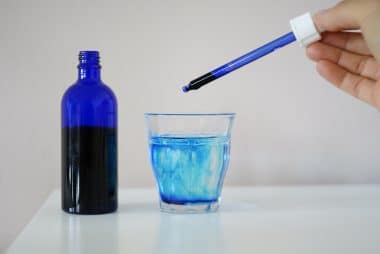Maximizing “Methylene Blue” By Boosting Its Therapeutic Potential
Methylene blue, a synthetic compound with a deep blue hue, has proven itself as a powerful agent across multiple domains… from treating medical conditions to disinfecting water and enhancing cognitive function. But as versatile as this molecule is, researchers and clinicians continue to find ways to boost its efficiency, making it even more effective and […]

Methylene blue, a synthetic compound with a deep blue hue, has proven itself as a powerful agent across multiple domains… from treating medical conditions to disinfecting water and enhancing cognitive function.
But as versatile as this molecule is, researchers and clinicians continue to find ways to boost its efficiency, making it even more effective and adaptable.
Enhancing methylene blue’s performance often involves pairing it with other compounds, leveraging light, or improving its delivery system, whether in therapeutic contexts or industrial settings.
Synergistic Partnerships: Pairing Methylene Blue with Other Compounds
One of the most effective ways to amplify the benefits of methylene blue is by combining it with compounds that complement its mechanisms of action. Among the most promising pairings is ascorbic acid, commonly known as Vitamin C.
In clinical studies, Vitamin C has demonstrated its ability to stabilize methylene blue and enhance its antioxidant effects. This combination has particular relevance in neurodegenerative disease models, where oxidative stress is a significant concern.
A 2016 study published in Oxidative Medicine and Cellular Longevity showed that methylene blue and ascorbic acid together reduced oxidative damage in neuronal cells better than either compound alone. The researchers concluded that the two substances worked synergistically to protect mitochondrial function and reduce reactive oxygen species.
Another powerful combination is curcumin, the active compound in turmeric. Curcumin itself is known for its anti-inflammatory and antioxidant effects, but when paired with methylene blue, the results are even more compelling.
Some experimental studies suggest this duo can work together to protect brain cells and reduce inflammation, particularly in models of Alzheimer’s disease and traumatic brain injury.
Similarly, resveratrol, a polyphenol found in grapes and red wine, has shown promise in boosting the neuroprotective capacity of methylene blue. In aging models, this combination has been observed to improve mitochondrial function and reduce cellular stress, offering hope for treating cognitive decline.
Lighting the Fire: Photodynamic Activation of Methylene Blue
Methylene blue is also well known as a photosensitizer, a substance that becomes activated when exposed to light—particularly red or near-infrared wavelengths. This property is key to its use in photodynamic therapy (PDT), especially for cancer treatment and antimicrobial applications.
When activated by specific light wavelengths, methylene blue produces singlet oxygen and other reactive oxygen species that can selectively destroy harmful cells. According to a 2018 review in Cancers, photodynamic therapy using methylene blue has been effective against various types of cancer cells, including melanoma and oral squamous cell carcinoma, without significantly affecting healthy tissue.
Moreover, light activation enhances methylene blue’s antiviral and antibacterial properties. Research has shown that combining methylene blue with visible light can effectively neutralize viruses like SARS-CoV-2 and bacteria such as MRSA, making it an ideal candidate for sterilization and infection control.
Microemulsions: Delivering Methylene Blue More Effectively
When it comes to topical or localized treatments, improving the bioavailability of methylene blue is essential. This is where microemulsions come into play. These mixtures of oil, water, and surfactants allow better absorption through the skin or mucous membranes.
Microemulsion formulations have shown particular promise in dermatological applications, where methylene blue is used to treat wrinkles, skin infections, or wounds. According to a study in the Journal of Drug Delivery Science and Technology (2019), microemulsions increased methylene blue’s penetration into the skin and preserved its chemical stability over time.
MCT oil or coconut oil may also help absorption.
This delivery method could also be applied in dental care, for example, when treating gum infections or during root canal therapies, where methylene blue is an antimicrobial agent.
Antioxidant Allies in the Fight Against Oxidative Stress
Oxidative stress is a major factor in aging, inflammation, and degenerative diseases. Methylene blue’s role in countering oxidative stress can be significantly amplified when used in combination with other antioxidants.
Methylene blue is widely recognized for its antioxidant properties, and its effectiveness can be significantly enhanced when combined with other antioxidants, particularly in medical and biological applications.
Alpha-lipoic acid, a versatile antioxidant soluble in both water and fat, can regenerate other antioxidants like vitamins C and E, and may amplify the neuroprotective benefits of methylene blue. Similarly, glutathione, a powerful endogenous antioxidant essential for cellular protection, can strengthen the antioxidant defense system when used in conjunction with methylene blue.
Vitamin E, including both tocopherols and tocotrienols, is a fat-soluble antioxidant that safeguards cell membranes from oxidative damage; when paired with methylene blue, it may offer improved defense against lipid peroxidation.
Coenzyme Q10 (ubiquinone), vital for mitochondrial energy production and also an antioxidant, can enhance mitochondrial function and help combat oxidative stress alongside methylene blue. Resveratrol, a polyphenol found in red wine and grapes, is known for its strong antioxidant and anti-inflammatory effects and may work particularly well with methylene blue in neuroprotective and cardiovascular contexts.
N-acetylcysteine (NAC), a precursor to glutathione, supports the body’s antioxidant defenses and could complement methylene blue in managing oxidative stress. Quercetin, a flavonoid with notable antioxidant and anti-inflammatory actions, can synergize with methylene blue, especially for cardiovascular and anti-inflammatory applications. Lastly, selenium, an essential trace mineral that contributes to the body’s antioxidant enzyme systems via selenoproteins, can also enhance the antioxidant potential of methylene blue.
These combinations can be strategically tailored for specific applications to maximize methylene blue’s therapeutic effects. However, thorough research and clinical testing are essential to ensure both safety and efficacy in medical and biological settings.
Chelating Agents: Unleashing Methylene Blue’s Detox Potential
Methylene blue also shows promise in detoxification, especially when paired with chelating agents like EDTA (ethylenediaminetetraacetic acid). Chelators bind to heavy metals and help the body eliminate them safely.
While methylene blue alone has some metal-binding capability, combining it with EDTA dramatically increases its efficacy in removing mercury, lead, and other toxic substances.
In a clinical context, this combination could be used to treat metal poisoning or to support individuals with chronic exposure to environmental toxins. However, more human trials are needed to standardize doses and establish long-term safety protocols.
Unlocking the Full Potential of Methylene Blue

Methylene blue is far more than just a stain for scientific slides or an old-school antiseptic. As research continues to reveal its broad-spectrum capabilities, the key to unlocking its full potential lies in combining it intelligently with other compounds, activating it properly, and delivering it effectively.
Whether through light, synergistic molecules like ascorbic acid or resveratrol, or enhanced delivery systems like microemulsions with MCT oil, methylene blue’s efficiency can be dramatically improved.
As more studies are published and applications refined, this vivid blue compound could play a leading role in the future of medicine and detoxification.
This content is for informational purposes only. Ask your doctor if methylene blue is right for you.
What's Your Reaction?































